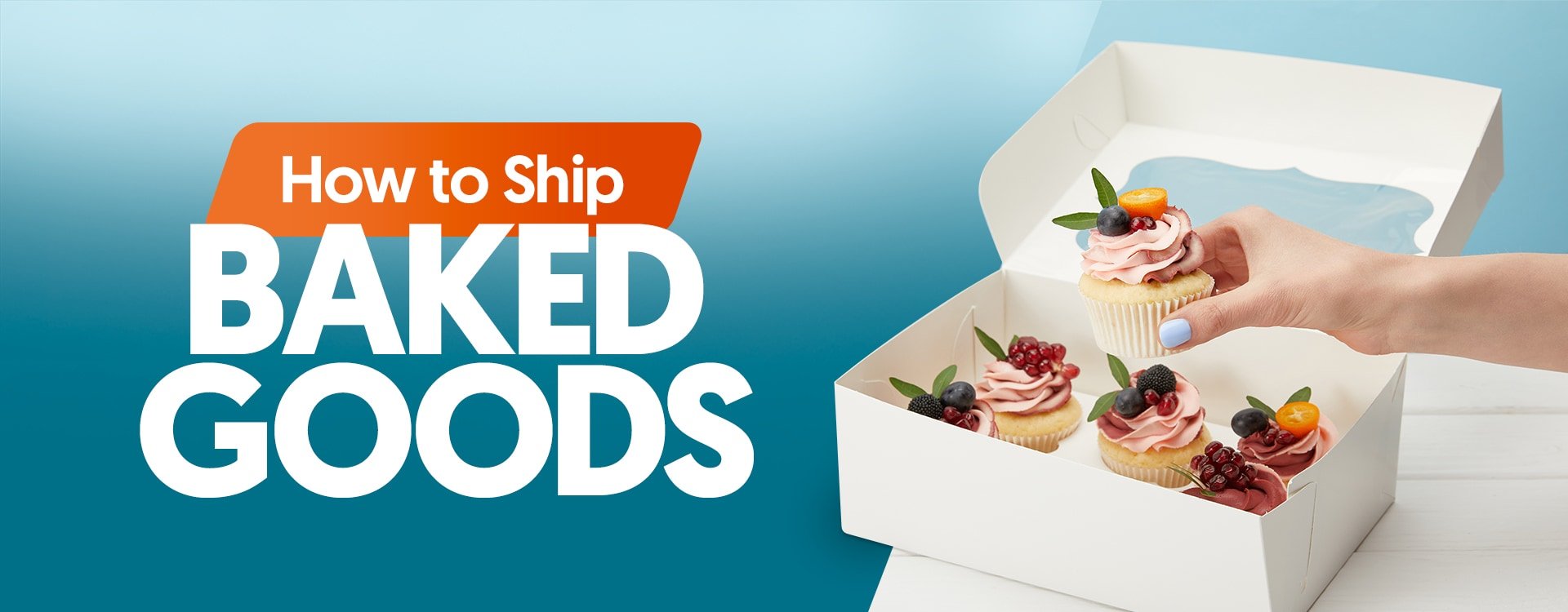If you develop a reliable shipping strategy, selling baked goods online can broaden your customer base or allow you to forgo a storefront. Mailing delicate, perishable pastries requires extreme care. Whichever type of bakery you operate, use our bakery shipping guide to ensure your customers receive fresh, safe-to-consume, and intact baked goods.
How to Ship Cookies
How to Ship Cookies without Breaking
Given their hearty nature, cookies are one of the best baked goods to ship. They transport so well, ghost kitchen entrepreneurs have created entire concepts around cookies. Household name Mariah Carey even has a virtual brand, Mariah's Cookies. However, some cookies ship better than others. Cookies with eggs in their recipe are sturdier than their eggless counterparts (ex. shortbread cookies), making them better candidates for shipping orders. We explain the ins and outs of how to ship cookies below.
How to Package Cookies for Shipping
- Wrap the cookies. If you’re shipping multiple types of cookies in one order, individually wrap each cookie in a sealed bag to prevent flavor diffusion. If you’re shipping cookies of the same flavor, you can arrange them back-to-back and loosely wrap them in plastic wrap.
- Secure the cookies. Fill the nooks and crannies in your box with packing supplies. Otherwise, your cookies will jostle and break in transit.
- Shake test your box. Give your box a shake to make sure the cookies aren’t slipping around before shipping them. Don’t skimp on the packing materials. The expense of the packing materials is nothing compared to losing a customer because their cookies arrived as a pile of crumbs.
- Use a shallow, flat container. Don't stack the cookie layers higher than two layers deep.
- Ship smaller cookies. Smaller cookies are less likely to crumble than larger cookies. Use a teaspoon rather than a 2" cookie scoop to make cookies for shipment orders. If customers are used to receiving giant cookies when they buy them on your bakery's premises, consider shipping multiple small cookies for the price of one large storefront cookie.
How to Ship Decorated Cookies
To prevent your cookies from crumbling in transit, use a food tin or box to protect them inside their shipping box. Start by creating a cushion layer of crumpled wax paper on the bottom of the cookie tin. Then add your wrapped cookies to the tin and top them with another cushioning layer of crumpled wax paper. These extra protections are especially helpful for shipping fragile and decorated cookies.
Should I Freeze Cookies before Mailing?
Freezing cookies before mailing them is an excellent way to protect them and help them stay fresh. Frozen cookies are more solid and less likely to break in transit. You can ship frozen cookies in their plastic packaging, saving you money on insulated shipping containers.
Most cookies freeze and defrost without altering their flavor or consistency. You can arrange your cooled cookies on a plate as you’d like to present them, wrap the plate in plastic, and freeze them together. Once frozen, your plate of cookies is ready for packaging. Typically, the moisture the cookies release as they defrost isn’t enough to make their package leak. However, since leaks go against USPS rules, it’s advisable to use water-soluble packaging materials.
How to Send Baked Goods in the Mail
If you’re sending sturdy baked goods locally, you can put pastries in priority mail. However, overnight shipping is the ideal way to send baked goods to preserve their quality. For fragile or temperature-sensitive items like cheesecakes, overnight shipping isn't just beneficial, it's required. Whether you’re packaging your goodies for the mail or shipment, follow our step-by-step instructions for shipping or mailing baked goods.
1. Package Your Baked Goods for Shipping
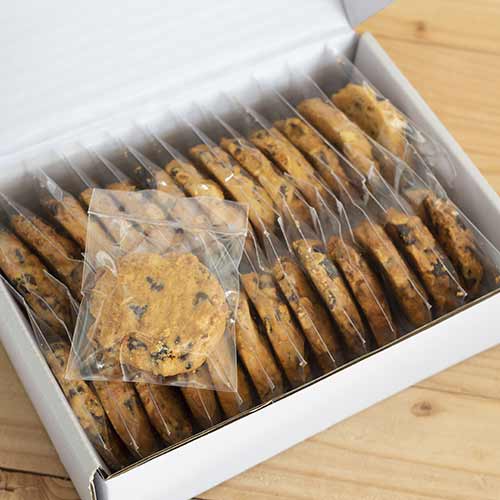
The ideal packaging for baked goods varies by the type of sweet treat you’re shipping. No matter what, you must secure them inside their shipping container. There is nothing more disappointing than receiving a crumbled pastry mess in the mail. We provide some bakery shipping tips that will help preserve the structural integrity of your sweets.
How to Package Baked Goods for Shipping
Follow these general guidelines to package baked goods for shipping and upgrade your small business shipping services:
- Cool baked goods before packing them. You should only package cooled baked goods to prevent moisture build-up.
- Secure each item. Use food-grade bags, parchment paper, or food liners to help keep them intact. Individual wrapping also prevents sticky treats from conjoining.
- Leave no wiggle room. Fill any voids in the box with bubble packaging or foam.
- Give your package a good shake. If you hear any rattling or feel jostling, reopen the package and add additional cushioning.
2. Create an Elevated Unboxing Experience
While your primary concerns are food safety and product quality, you also need to consider your customer’s unboxing experience. Memorable tins and packaging build excitement. A great presentation prompts customers to post their unboxing experience on social media, providing you with free advertising. It can also help boost brand loyalty and encourage repeat sales.
How to Create the Perfect Unboxing Experience
The primary goal of unboxing is to increase your customers’ value perception. The moment they receive your package, patrons evaluate its quality and whether it was worth purchasing. From the box you send it in to how you organize it, we explain how to create the perfect unboxing experience below:
- Package your baked goods in branded boxes. It builds anticipation when customers can tell where their package came from as soon as it arrives.
- Use attractive and sustainable packing materials. Customizing your internal materials ties your overall aesthetic together. If you use sustainable packaging, include an insert that shares this information with your customers. Environmental responsibility can earn respect and boost brand loyalty.
- Thoughtfully lay out your products. Use dividers to manage your products' placement. Consider the color scheme of the cushioning that you choose and how it compliments your items. Browse the social media hashtags #unboxing and #flatlay for inspiration.
- Give free samples. Free samples encourage repeat business and introduce your clients to your other product lines. For example, if your customer ordered a shipment of your banana bread, consider adding a sample of your cake pops.
- Personalize the package. From handwritten notes to customizable gift packaging, personal touches can go a long way in earning brand loyalty.
- Leverage inserts. Physical inserts carry greater weight than emailed information. You can insert coupons, new flavor/product promotions, or branded stickers.
- Mark the package as perishable. This is for the customer, not the carrier! If someone sends your baked goods as a gift, you want the recipient to know they should open the box immediately. Apply a "use by" sticker so recipients know exactly when you made the baked good and how long they have to enjoy it.
3. Choose a Shipping Service
You must decide how you want to ship your baked goods. While ground services are less expensive, air delivery services help keep your perishable treats fresh, especially if you're sending them several states away. You'll need to weigh your packages because their weight affects shipping fees. Select overnight, next-day, or two-day air shipping to keep temperature-sensitive items safe.
Talk to different carriers’ customer service representatives and see which team you feel best working with. The success of your bakery’s e-commerce business depends on customers receiving their orders fast and intact. You need to have a good working relationship with your shipping company.
How Much Does It Cost to Ship Baked Goods?
The carrier will determine the cost of shipping your baked goods based on the package’s weight, dimensions, and distance traveled. EasyShip provides a shipping rate calculator that compares your shipping options. In most cases, UPS and FedEx are in the same price range and offer the same guarantees
Which Shipping Service Is Best for Shipping Baked Goods?
The best shipping service for baked goods depends on the volume and type of baked goods you’re sending. We explain the benefits of different carriers below:
- USPS - The US Postal Service provides the best rates on small, lightweight packages and usually offers fast delivery timelines.
- UPS - For large and/or heavy shipments, use UPS to get the best rate. Given their expedited shipping times, UPS is also ideal for highly perishable deliveries.
- FedEx - FedEx offers niche shipping services for frozen food and businesses.
The Cheapest Way to Ship Baked Goods
In most cases, USPS is the cheapest way to ship baked goods. We break down the cheapest ways to ship baked goods using USPS below:
- Packages Under One Pound - USPS First-Class Package Service is the cheapest shipping option for packages that weigh less than 1 lb. (16 oz). This service will deliver packages between 1 and 3 business days. Depending on where you’re shipping to, it may only cost $3 or $4 per package. However, First Class Package doesn’t provide USPS insurance, so we recommend purchasing shipping insurance in case something goes wrong.
- Packages Over One Pound - USPS Priority Mail Cubic prices shipping fees based on a package’s outer dimensions, not its total weight. This allows you to ship fully loaded packages for the same price as lightly loaded packages. USPS Priority Mail Cubic offers 1-3 business day delivery and comes with insurance up to $100. The fine print: the package’s total weight must not exceed 20 pounds and its total volume must be under 0.5 cubic feet.
4. Ship Baked Goods at the Beginning of the Week

The best time to ship baked goods is early in the week. Sweets shipped on Fridays often get stuck in sorting facilities over the weekend. The likelihood of delays goes up later in the week, increasing the chances that your customers will receive stale loaves of bread, or worse, sweets that have fallen into the food safety temperature danger zone.
Tips for Maintaining Freshness in Shipped Baked Goods
While shipping your baked goods early in the week and avoiding Friday shipments will help them arrive on time, there are other practical shipping strategies for maintaining product freshness. Discover the top bakery shipping tips below:
- Create a shipping timeline. Map out exactly how long it will take you to get your cooled baked goods into your customers' hands. If you can’t get frosted or cream-filled items to your customers quickly, you’ll have to cut these items from your bakery's shipment order offerings.
- Set order cut-off times. Setting a cut-off time will keep you, your customers, and your shipping carrier on the same schedule. If you're worried about losing clientele, you can always offer a rush delivery service for an additional fee.
- Offer custom tracking. Use a post-purchase platform like parcelLab to create a customized tracking page. Provide food storage instructions, serving suggestions, and coffee pairing ideas on your custom page.
- Communicate shipping fees early. State shipping options and fees early in the ordering process. Perishable items require additional packaging and rushed timelines, leading to higher shipping costs than nonperishables. You don’t want customers to make it all the way to check out and then abandon their order because of false shipping cost expectations.
- Consider including shipping in the sales price. Providing "free shipping" presents an accurate picture of the total expense of ordering your sweets from the start. Adding “shipping included” in the product description helps prevent failed conversion because of shipping fees.
- Bake with invert sugar. While well-executed shipping is important, the ingredients you use for your baked goods affect their shelf life and freshness, too. Invert sugar retains moisture and keeps baked goods fresh. Sub invert sugar for table sugar to improve your shipped baked goods' quality.
How to Ship Different Baked Goods
Now that you understand the big picture of shipping baked goods, learn how to package each type of baked good for shipping. In the following sections, we break down how to prepare the most popular bakery items for shipping.
How to Ship Macarons
Follow these steps to protect your delicate French macarons in transit:
- Place your macarons in a macaron container. These French pastries are extremely fragile, so they require sturdier packaging than other types of cookies. Their strong flavors diffuse, so we recommend using airtight packaging and separating flavors.
- Use a shipping box that snugly fits your plastic container. You don’t want to leave room for the plastic container to knock around during transit.
- Slide ice packs around the macaron container. This keeps them fresh and safe to consume.
- Use packing materials. This keeps the macarons in place during the shipping process.
- Choose next-day shipping. Work with a carrier you trust.
How to Ship Bread
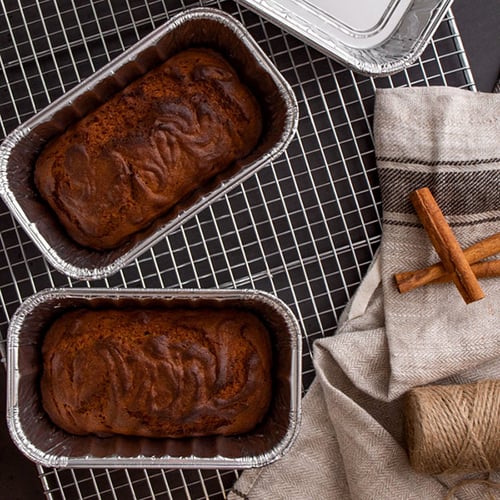
Homemade bread is time-consuming to make but delicious. Many would rather order bread from a premium bakery than try to make it themselves. However, not all loaves of bread ship as well as others. The best type of bread to ship is quick bread leavened with baking powder or soda such as pumpkin, zucchini, and banana bread. Unyeasted, "quick bread" is heartier and has a longer shelf life than yeast-risen dough. Your next best choice is bread leavened with sourdough. Yeast-leavened bread has the shortest shelf life and is the most fickle, making it the most challenging type of bread to ship.
Steps to Ship Bread
Bake your bread on the same day you ship it. Make sure the loaf is completely cool before packaging it. Then, follow these steps:
- Wrap the bread. According to USPS, there are unique methods for wrapping different types of bread. You should double-wrap soft bread in plastic wrap before wrapping it in either a plastic bag or foil. Wrap your stiff, yeast-leavened bread in foil before wrapping it in plastic or adding it to a bread bag. You should wrap crusty bread in plastic wrap or put it in a plastic bag to preserve its moisture before shipping it. While the crust will inevitably soften, this is still preferable to stale bread.
- Package your bread in a sturdy box. A padded envelope will not provide enough protection for your bread. Choose a box that can house your bread without smashing it.
- Fill empty spaces in the box with packing supplies. Bubble packaging is an excellent choice for cushioning shipped bread.
- Seal the box with carton sealing tape. Make sure there aren’t any openings. An airtight box will help keep the bread fresh.
Consider Par Baking Your Bread for Shipping
Par baking stands for “partially baking”. To par-bake bread, bake the dough 80% of the way and then freeze the loaf. Quick freezing with a blast chiller kills the yeast’s future power and creates a stable inside without browning the crust. The customer can finish the bread by baking it for an additional 10-15 minutes when it arrives. This allows the customer to enjoy a truly fresh, perfectly browned, and warm loaf of bread.
How to Ship Banana Bread
We explain how to wrap, package, and ship banana bread. You can use this method for other moist, quick loaves such as pumpkin, zucchini, and glazed lemon bread.
- Lay the plastic wrap on a flat surface. You can use a baking sheet, cutting board, or cleared countertop.
- Place the loaf on top of the plastic wrap. Leave enough plastic wrap on the left-hand side to fold over the banana bread.
- Cut a piece of wax paper the size of your loaf. Lay it on top of your bread to preserve its moisture.
- Wrap the banana bread in your sheet of plastic wrap. Fold the plastic wrap to the left of your banana bread over the loaf. Then, roll the bread down the length of the plastic wrap. Tuck the plastic wrap at the top and bottom of your loaf into the roll as you turn the bread.
- Freeze the banana bread. Freezing the banana bread before shipping will help keep it fresh.
- Lay down a sheet of aluminum foil. Not only will aluminum foil protect your loaf, but it will also shield your banana bread from flavor-altering odors.
- Remove the banana bread from the freezer and place it on the foil. Place the foil on the left side of the banana bread over it, then roll your loaf in the aluminum foil, tucking the top and bottom pieces of foil into your roll as you go.
- Place your loaf in a sturdy bakery box, tin, or container. Choose a container that fits your loaf snugly. Add packing materials to any empty spaces.
- Load your container into a similar-sized shipping box. Fill any gaps with packing supplies to secure the container.
- Seal the box with carton sealing tape. Make sure there aren’t any openings. An airtight box will help keep the banana bread fresh.
- Ship the banana bread. Work with a carrier you trust and choose either overnight or two-day shipping to ensure product freshness.
How to Ship a Cake
Unfrosted cakes, coffee cakes, fluted tube pan cakes, and pound cakes are the best candidates for shipping. These cakes freeze and defrost well, so shipping them frozen is a great way to preserve product freshness. Frosted cakes are harder to ship than other baked goods, but it is possible with the right tools and techniques.
How to Package Cakes for Shipping
If you’re wondering how to ship a cake with frosting, this is the best way to package frosted cakes for shipping:
- Use a cake shipping box. A fitted Styrofoam mailer prevents the cake from jostling in transit.
- Keep the cake cool. Remove frozen cool packs from the freezer and insert them around the cake.
- Insert the mailer into a box. You want a mailer that fits the box perfectly and leaves no room on the sides.
- Seal the box. Tape all its seams and smooth them down.
- Use stickers to mark the outside of your box. Show where the top of the box is so transporters don’t tip your cake upside down. Mark it as perishable and fragile.
- Your cake is ready to be shipped. Choose overnight shipping and work with a carrier you have a good relationship with.
How to Ship Pound Cake
Pound cakes ship best in their disposable aluminum pans. Use wax paper or plastic wrap to cover the pound cake in its pan. Place the wrapped pan in a plastic bag and add it to a cushioned food box.
How to Ship Cupcakes
Once you've baked and decorated your cupcakes as desired, chill them in the fridge or freeze them for a few hours before packaging them for shipping. This will help preserve their flavor during transport. Because cupcakes are delicate and perishable treats, you need to follow a strict packing process to ensure they arrive intact and safe to consume.
To ship cupcakes, you must purchase a cupcake container. Choose between a plastic cupcake box with individual compartments or cupcake bakery box inserts. Either option will shield your cupcakes’ frosting and prevent them from knocking into each other. Protect the cupcakes by placing candy sticks in the center of each cupcake and trimming the sticks so they hit the lid of the cupcake box. This anchors the cupcakes in place and prevents their frosting from smashing into the lid.
Cupcake Shipping Supplies List
- Cupcake box and/or cupcake inserts
- Candy sticks
- Ice packs
- Shipping Box
- Tape
How to Ship a Pie
Shipping a pie requires two boxes for double protection and plenty of cushioning materials. We explain how to ship a pie below:
- Make your pie. We suggest sticking to fruit-filled or nut pies and avoiding dairy-laden or meringue-topped options.
- Freeze your pie. Pies freeze and defrost well. Frozen pies stay fresher and stiffer, helping retain structural integrity in transit.
- Gather your shipping materials. You’ll need bubble packaging, a pie box, a corrugated cardboard box, and carton sealing tape.
- Add your frozen pie to the pie box. Pie boxes are specifically designed to prevent structural damage to pies, and some even offer security features such as locking corners.
- Decorate the pie box. Wrapping the pie box in branded gift paper, adding a handwritten note, or providing pairing/serving suggestions boosts brand loyalty.
- Wrap the pie box in air bubble packaging. Once you pad it, place the pie in the center of a corrugated cardboard box.
- Surround the pie with ice packs to keep it cool. Cushioned ice packs serve the dual functions of protecting the pie's food safety and structural integrity.
- Fill in any gaps. Add packing materials to prevent the inner box from sliding around during transit.
- Seal the pie box with carton sealing tape. Make sure there aren’t any openings. An airtight box will help keep the pie fresh.
- Ship your pie overnight. Pies are perishable and need to arrive fast and fresh.
How to Ship Brownies
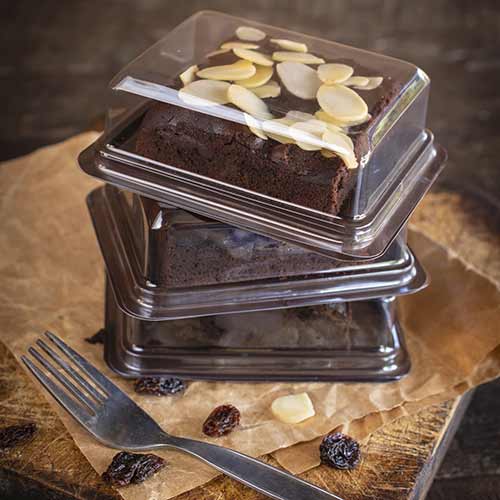
Brownies are one of the best baked goods to ship. We explain how to package brownies for shipping so your customers receive fudgy, fresh, and fantastic brownies in the mail.
- Cut brownies into small squares. Small brownies have less circumference to break down in transit.
- Wrap brownies individually. If you’re shipping your brownies to a humid environment, wrap each brownie in foil to protect them from humidity. If you’re shipping your brownies to an arid environment, wrap each brownie in plastic wrap to protect them from dry heat.
- Place the tightly wrapped brownies in the freezer. Frozen brownies are firmer and hold their form in transit, and they stay fresher during transport.
- Box the brownies. Place the individually wrapped brownies inside a box, tin, or plastic container for protection.
- Slip the box of brownies into a shipping box. Stuff packing materials around the brownies so they remain fixed during transit.
- Seal the box with carton sealing tape. Make sure there aren’t any openings. An airtight box will help keep the brownies fresh.
Shipping Brownies Tips
Wondering how to mail brownies so they arrive as perfect, fudgy squares? We provide the top tips for shipping brownies below:
- For the freshest results: Ship an entire tray of brownies. Uncut brownies stay freshest, so this is the best shipping option. Lay aluminum foil down in your baking dish before adding the brownie batter so you can easily remove the brownies from the pan after they're baked. Use a large enough piece of aluminum foil to fold over the top of the brownies, and it will double as packaging.
- For bulk orders: If you want to package a few brownies together, lay parchment paper down at the bottom of their container. Add a layer of brownies and cover them with parchment paper. Repeat until your container is full.
- For moisture: Adding chocolate chips to the batter helps keep the brownies moist.
- For food safety: Subbing vegetable oil for butter in the brownie recipe helps them stay safe to consume after transit.
Shipping Baked Goods FAQ
Now you know how to start a shipping service for your bakery and how to package each of your baked goods for shipping. But you still have some questions, and we’re way ahead of you. From a list of baked goods that ship well to a bakery shipping supplies list, we outline the nitty-gritty details of shipping baked goods in this FAQs section.
Best Baked Goods to Ship
The best baked goods to ship are sturdy and aren’t prone to melting. Whole baked goods stay fresher than cut baked goods, so shipping a pie vs. a slice of pie is always best. Ideally, you want to ship baked goods you can wrap individually. We provide a list of the best baked goods to send in the mail with examples by their type below:
- Bread - Quick bread such as banana bread, pumpkin bread, and zucchini bread does great in the mail.
- Cakes - Unfrosted cakes such as pound cakes, fluted tube pan cakes, and coffee cakes arrive intact and fresh after shipping.
- Pies - Fruit/nut pies like cherry, apple, blackberry, and pecan are perfect for mail-ordered sweets.
- Cookies - Most cookies with eggs in their recipe ship well. Cookies without sticky mix-ins such as oatmeal raisin, snickerdoodle, and chocolate chip ship best.
- Bars - Brownies, blondies, and magic bars are some of the best baked goods to ship.
List of Baked Goods That Don’t Ship Well
Just like certain baked goods hold up well in the mail, others lose their form and flavor. Dairy-rich treats require low temperatures for safe consumption, so they make poor shipping candidates. Items with delicate toppings often arrive smashed and ruined.
Sticky sweets, like caramel and toffee, cling to packaging and other baked goods, ruining their presentation. This doesn't mean you can't successfully ship these items with the proper packaging, but it will be more expensive. You will also run a greater risk of product loss and customer dissatisfaction. Discover the riskiest baked goods to ship by their type below:
Bakery Shipping Supplies
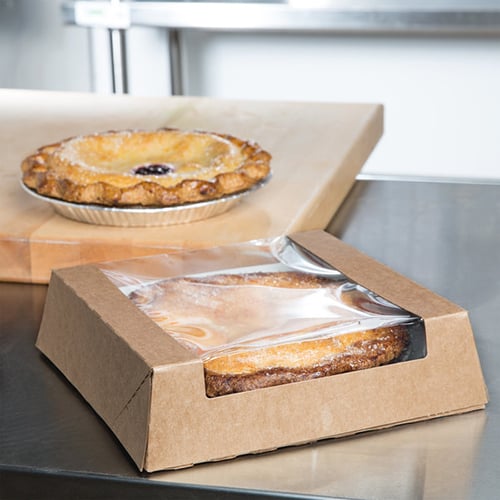
Whether you’re selling baked goods on an e-commerce platform or filling nationwide shipping orders, here are the bakery shipping supplies you’ll need:
- Aluminum Foil Pans - cake pans, pie pans, tart pans, and Danish pans
- Bakery Boxes - cake boxes, cookie boxes, box insert kits, pastry boxes
- Cupcake/Muffin Takeout Containers - cupcake boxes, hinged cupcake containers, cupcake inserts
- Disposable Baking Pans - disposable paper and plastic bakeware, disposable loaf pans
- Disposable Baking Tools - cake pop sticks, bun rack covers, piping bags, pipettes
- Insulated Shipping Supplies - round cake/pie shipping boxes, insulated bubble packaging, food pan shippers, box liners, multi-depth shippers
- Cardboard Shipping/Mailing Boxes - stock up on a variety of cardboard shipping box sizes
- Mailing/Shipping Labels - shipping tags, mailings tags, handling labels
- Cold Packs - gel cold packs, thermal cold packs, flexible ice mats, foam cold packs, ice packs
- Packing Paper - stock up on wholesale rolls and sheets of packing paper
How to Keep Baked Goods Fresh for Shipping
To keep your baked goods fresh for shipping, bake and ship your treats on the same day. Make sure your baked goods are completely cool before you package them. If you’re sending shipping-friendly treats, Priority Mail will usually get your goodies to your customers on time. However, for dairy-laden, frosted, or heat-sensitive sweets, you’ll need to select next-day delivery.
Back to TopEspecially around the holidays, sending baked goods in the mail is a popular way to show each other we care. Whether you're starting an online bakery, hoping to tap into remote markets, or simply want to send your loved ones a care package, reference back to this guide to ship your baked goods. With these best practices in mind, your goodies will arrive fresh, intact, and safe to consume.
